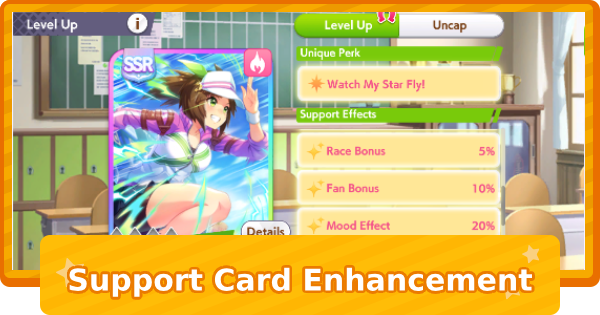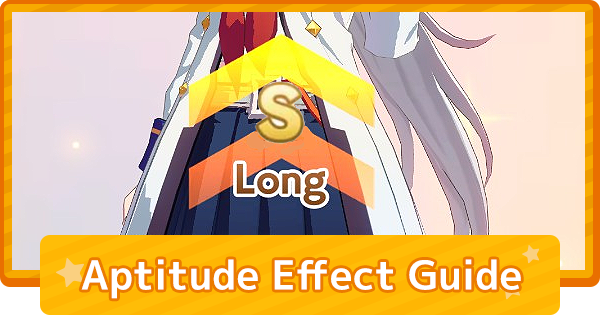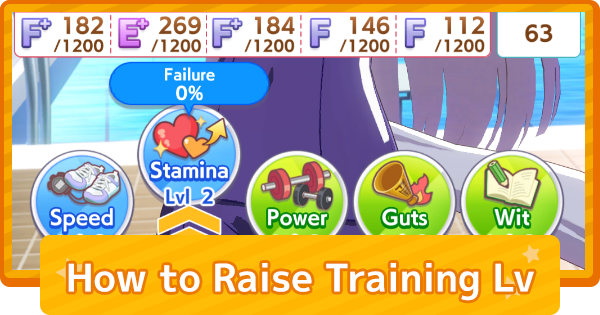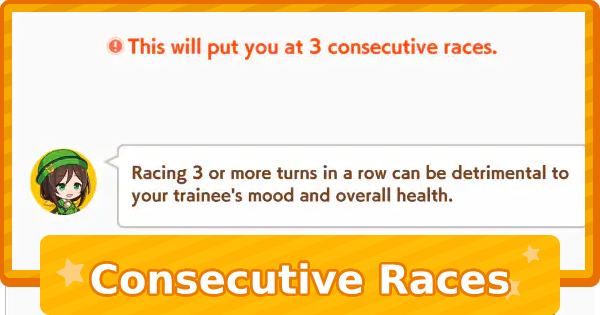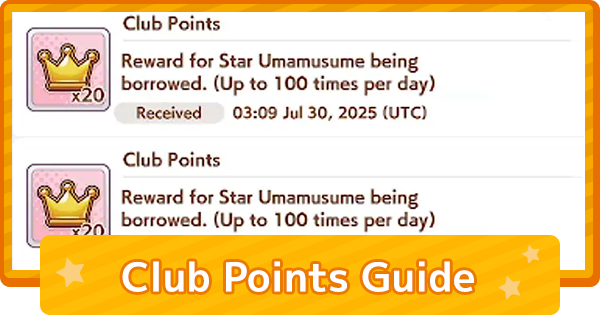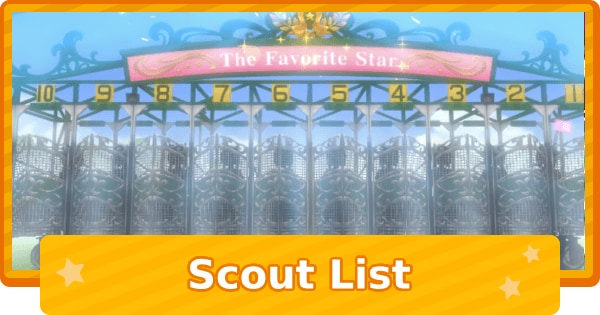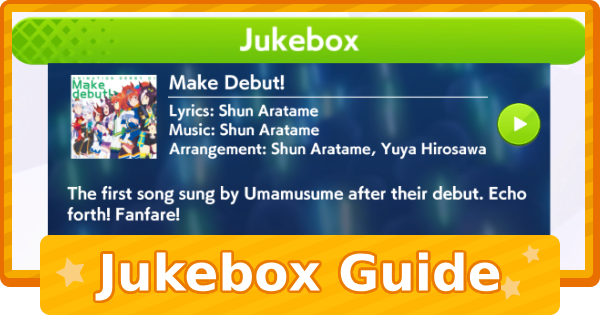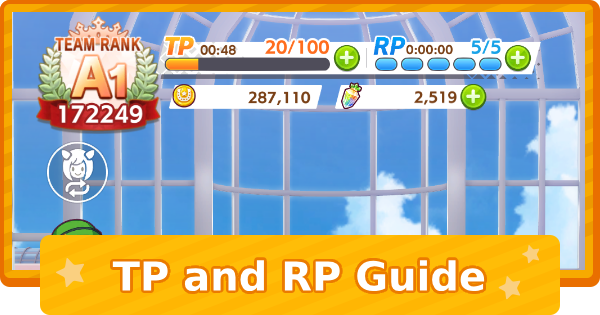This is a glossary for Umamusume: Pretty Derby. Including a detailed compilation of specialized terms and keywords. Designed to help you understand core mechanics, scenario-specific terminology.
*Some terms based on the official glossary of Umamusume: Pretty DerbyA-B-C Terms
| Acupuncturist |
|---|
| There are acupuncturists who specialize in treating Umamusume, providing a variety of beneficial effects to their bodies with the use of distinct needles shaped like bamboo leaves. |
| Agenda |
| A long-term plan listing the races in which an Umamusume plans to enter. Trainers usually build an agenda around G1 races suitable for their trainee in terms of distance and track surface, with G2 and G3 races slotted in as trial races leading up to those bigger objectives. |
| Backstretch |
| The straightaway of a racetrack on the opposite side from the stands. See also: Homestretch |
| Big Eight |
| A set of G1 races with particularly long traditions: the Oka Sho, Satsuki Sho, Tenno Sho (Spring), Japanese Oaks, Japanese Derby, Kikuka Sho, Tenno Sho (Autumn), and Arima Kinen. There is no greater honor for a trainer than to have trained a winner in each of the Big Eight. These races had already attained their status even before the Twinkle Series took on its current form, and they continue to be treated as in a league of their own above the newer G1 races. |
| Bracket |
| Brackets are a grouping of one to three runners based on post position. Regardless of field size, the maximum number of brackets is eight. For example, if there are nine runners, bracket eight will have two runners, post numbers eight and nine, while brackets one through seven will have one runner each. Brackets closer to one are called inner brackets, while brackets closer to eight are called outer brackets. Each bracket has a corresponding color, which can be seen reflected in the color of the runner's post number on a racecard, or in the color of her trackwear during a G2 or lower race. Bracket 1: White (or gray on trackwear) Bracket 2: Black Bracket 3: Red Bracket 4: Blue Bracket 5: Yellow Bracket 6: Green Bracket 7: Orange Bracket 8: Pink See also: Post |
| Break |
| To break is to leave the starting gate at the beginning of a race. One may describe a runner as "breaking" well or poorly. |
| Breather |
| To take or get a breather during a race, especially a long-distance one, means to take a moment to regain one's composure. |
| Central |
| Describes all ten racecourses managed by the URA: Sapporo, Hakodate, Niigata, Fukushima, Nakayama, Tokyo, Chukyo, Kyoto, Hanshin, and Kokura. Races held at Nakayama, Tokyo, Kyoto, or Hanshin are called "Central," while those held at Sapporo, Hakodate, Niigata, Fukushima, or Kokura are called "Local." Chukyo was originally designed as a local racecourse, but in recent years, it has sometimes been included in the central category. The term can also refer to the Twinkle Series itself. See also: URA, Regional |
| Challenge |
| To challenge a runner during a race means to attempt to pass her from behind, especially during the final stretch. If the challenged runner maintains her lead, she is said to have "held off" or "turned back" the challenge. |
| Charge Up |
| To charge up means to conserve energy when getting into the preferred position for one's running style. Only runners with an abundance of Power can charge up. |
| Classic Triple Crown |
| Refers to the feat of claiming victory in three prestigious G1 races for classic year runners: the Satsuki Sho, Tokyo Yushun (Japanese Derby), and Kikuka Sho. |
| Classic Year |
| The year after an Umamusume debuts, and the only year in which she is able to run in the prestigious Classic and Tiara races, such as the Japanese Derby and Oka Sho. Up through May of her classic year, when the Japanese Derby is held, a runner may only compete against runners in the same year. From June onward, she may enter the same races as runners in their senior year, though there are still some races later in the year limited to classic year contenders. |
| Classics |
| A set of five long-standing G1 races restricted to Umamusume in their classic year: the Oka Sho, Satsuki Sho, Japanese Oaks, Japanese Derby, and Kikuka Sho. The history and tradition behind the Classics make them particularly prestigious even among G1 races. |
| Cleat |
| The distinctive crescent-shaped metal supports attached to Umamusume racing shoes. By reinforcing the soles of the shoes, they lighten the load on the legs and allow the feet to tread firmly on the ground when running. Since these cleats greatly affect performance, runners maintain them diligently. Cleats are carefully crafted by artisans called cleatmakers, and some Umamusume are even said to use one-of-a-kind custom cleat designs. |
| Coach |
| Officially called Trainer, but English players gradually adopted 'Coach' as a more informal term. The EN players also use terms like Coach Rank, Coach ID, and Coach Profile. |
| Corner |
| The turns on a racetrack can be conceived of in terms of either two turns, or as is more common in Japan, four corners. These are called simply the first, second, third, and fourth corners in the order that they are passed during a race, with the second and third corners typically separated by the backstretch. |
| Cuties |
| A popular series of plushies modeled on Umamusume, known for being offered as prizes in claw machines. To be chosen as the model for a Cutie is a sort of status symbol among Umamusume. |
D-E-F Terms
| Derby Umamusume |
|---|
| An Umamusume who has won the Japanese Derby |
| Director |
| The head of Tracen Academy who has full authority over the school's operations. The current director, Yayoi Akikawa, is a passionate educator who pours her soul into supporting each and every student, going to such lengths as to expand training facilities for Umamusume who are trying their best. See also: Tracen Academy |
| Dirt |
| A type of track surface consisting of dirt and sand. Dirt races are particularly common in the United States and the Middle East. |
| Distance (DST) |
| A margin of more than ten lengths from the following runners. |
| Distance Aptitude |
| A measure of how well a runner is suited to different race distances (sprint, mile, medium, and long). If a runner races at a distance for which she has low aptitude, she will likely struggle to match the speed of others. |
| Dormitory |
| Tracen Academy provides on-campus housing for not only students, but also trainers and faculty. Though not mandatory, most opt to stay in them, as many people come to Tracen from distant parts of the country or even overseas. |
| Double Crown Champion |
| An Umamusume who has won two of the Triple Crown races: the Satsuki Sho, Japanese Derby, and Kikuka Sho. A runner may be dubbed a Double Crown champion following a win in the Japanese Derby, then later become a Triple Crown champion after the Kikuka Sho. |
| Dream Trophy League |
| A racing league positioned as the next step in the careers of Umamusume who have performed well in the Twinkle Series. Highly popular due to the dream match-ups between superstar runners it offers. The league centers around two Dream Trophy races held in the summer and winter, for which there are qualifying rounds. Once transferred to the Dream Trophy League, runners may no longer participate in the Twinkle Series. |
| Drop Out |
| To drop out means to fall behind in a leading position toward the end of the race due to a lack of endurance. When runners begin to drop out, those coming up from behind may find their paths blocked and struggle to weave past, even with sufficient endurance remaining. |
| Dual Dirts |
| Refers to a notable pair of G1 dirt races, the February Stakes and the Champions Cup, both held by the URA. |
| Dual Grand Prix |
| Refers to the pair of Grand Prix races, the Takarazuka Kinen and the Arima Kinen |
| Dual Miles |
| Refers to a notable pair of G1 mile races, the Yasuda Kinen and the Mile Championship, both run over 1,600 meters on turf. |
| Dual Springs |
| Refers to a notable pair of G1 spring races, the Takamatsunomiya Kinen and the Sprinters Stakes, both run over 1,200 meters on turf. |
| Dueling |
| Two or more runners become Dueling in the final stretch of a race if they are engaged in a close struggle for the lead. Those with higher Guts are able to raise their speed more dramatically in such situations. |
| End Closer |
| A strategy in which the runner conserves stamina at the very back of the pack before closing the gap down the stretch at the end of the race. |
| Epithet |
| Are the short titles or nicknames that appear beside a character’s name, typically earned through achievements, completing certain goals, or winning specific races. EN players informally use the term 'Title' instead of Epithet. |
| Fade |
| To fade means to lose speed in the final stages of a race due to a lack of endurance. |
| Fan Fest |
| A school festival held by Tracen students for their fans twice a year, once in the spring, and once in the fall. See also: Spring Fan Fest, Solefall Faire |
| Fanfare |
| The music played to announce the start of a race. Differs depending on both the racecourse and grade of the race. For example, G1 races have one fanfare for the Nakayama and Tokyo racecourses, and another for Kyoto, Hanshin, and Chukyo. Furthermore, the Takarazuka Kinen at Hanshin has its own fanfare, as does the Tokyo Daishoten at Oi. |
| Firm |
| The best of four designations used to describe the level of moisture in the ground at a racecourse due to precipitation. A firm track is dry and generally considered the easiest to run on. |
| Form |
| A runner's physical condition and readiness going into a race. For example, a runner who appears well-prepared may be described as in "good form." |
| Front Runner |
| A strategy in which the runner immediately goes to the front and leads the pack all the way to the finish. |
| Fuchu |
| The Tokyo Racecourse is sometimes called Fuchu due to its location in Fuchu City, west of central Tokyo. |
| Full Gate |
| The maximum number of runners that can start in a given race. Differs depending on the racecourse. For example, one may speak of a "full gate of sixteen" or a winner "besting a full gate." Due to their prestige, G1 races often attract a full gate. |
| Fully Charged |
| A runner who has successfully "charged up" becomes Fully Charged going into the last spurt of a race, using that conserved energy to accelerate. Only runners with an abundance of Power can become Fully Charged. |
| Furlong |
| A unit of distance defined as the equivalent of 200 meters. |
| Furlong Marker |
| A sign placed on the inside of a racetrack to indicate the remaining distance until the finish line. A sign that reads "2" means there are 200 meters left, not two furlongs (400 meters). |
G-H-I Terms
| G1 |
|---|
| The highest level of race in the Twinkle Series. Even when compared to other graded races, winning a G1 is an exceptionally difficult feat that many Umamusume can only dream of. |
| Gold Skill |
| Refers to Rare Skill or skills with a gold background. High-tier skills that have stronger effects than standard (white) skills. Often unlockable through skill evolution, events, or inherited factors. |
| Good |
| The second of four designations used to describe the level of moisture in the ground at a racecourse due to precipitation. A good track contains a comfortable amount of moisture and is considered ideal for dirt surfaces. |
| Grade |
| All races aside from Make Debut and Maiden races can be classified into one of five ranks according to prestige. From highest to lowest, these are G1, G2, G3, OP (Open), and Pre-OP (Pre-Open). Runners generally begin their careers in OP and Pre-OP races before working their way up to G3 and G2s, and eventually aiming for victory at the G1 level. |
| Grade Race |
| A collective term for G1, G2, and G3 races. More prestigious than the OP and Pre-OP levels. |
| Grand Prix |
| Refers to two G1 races where the field is decided by popular vote: the Arima Kinen in late December and Takarazuka Kinen in late June. The name reflects the degree of attention these races garner among fans as grand showdowns between top runners in terms of both popularity and ability. |
| Grand Prix Umamusume |
| An Umamusume who has won at least one of the two Grand Prix races, the Arima Kinen and Takarazuka Kinen. |
| Head (HD) |
| A margin of approximately forty centimeters from the following runner. |
| Heavy |
| The worst of four designations used to describe the level of moisture in the ground at a racecourse due to precipitation. A heavy track contains an extreme amount of moisture, to the point of being covered in puddles, and is extremely difficult to run on regardless of surface type. |
| Hit the Board |
| The hit the board means to place in the top five. Because the scoreboard at a racetrack displays results up to fifth place. If a runner finishes in the top five, her number will "hit the board," so to speak. See also: Scoreboard, Place |
| Homestretch |
| The straightaway of a racetrack adjacent to the stands. See also: Backstretch |
| Inner / Outer Track |
| While most racecourses consist of a single oval track, the Nakayama, Niigata, Kyoto, Hanshin, and Oi racecourses feature a larger outer track which shares some of its length with a smaller inner track. This allows for a greater variety of distances to be run on the same track. |
| Inspiration |
| The lingering hopes and dreams of those who once carved their names into racing history may spark inspiration in the hearts of those who aspire to follow in their footsteps. It is tradition at Tracen Academy for students to pray to the statue of the Three Goddesses for inspiration. See also: Spark, Three Goddesses |
| Instructor |
| Faculty members of Tracen Academy are responsible for the education of students who have yet to find a personal trainer. As instructors typically focus on improving the fundamentals and teach groups of ten to twenty at a time, they cannot tailor training sessions to individual student needs. See also: Trainer, Tracen Academy |
J-K-L-M Terms
| Junior Year |
|---|
| The year in which an Umamusume debuts. Those in their junior year can only enter races that are exclusive to junior year runners. |
| Kasamatsu Racecourse |
| A regional racecourse located in Gifu Prefecture. Oguri Cap originally raced at Kasamatsu Racecourse. |
| Kick |
| If a runner has a strong kick, it means she excels at pulling ahead with an explosive burst of speed in the final stretch of a race. One may also use it as a verb to say, for example, she "Kicked from Behind" or "Kicked Hard." |
| Late Surger |
| A strategy in which the runner hangs back toward the middle of the pack before surging ahead late in the race. |
| LB / Limit Break |
| Limit Break is officially called Uncap (Uncap Limit). It refers to the process of upgrading a Support Card or Umamusume by using duplicate copies (or certain items) to raise its power and unlock more features. Each LB Level is also Referred to as: No Uncap = 0LB 1 Uncap = 1LB 2 Uncap = 2LB 3 Uncap = 3LB 4 Uncap/Max = MLB |
| Leader |
| The runner in first at any given moment during a race. One may also speak of "leaders" plural. See also: Trailer |
| Length |
| A unit of measurement roughly equal to 2.5 meters used to describe the distances between runners in a race. The measure of one length is said to derive from the arm span of the Umamusume, on whom goddess statues are modeled. |
| Local |
| Describes racecourses managed by the URA where G1 races are not generally held: Sapporo, Hakodate, Fukushima, Niigata, and Kokura. |
| Long |
| A race distance of 2,401 meters or longer. A runner who excels over this distance is called a "stayer." |
| Maiden Race |
| A race limited to Umamusume who did not win their Make Debut. A runner with no career wins cannot enter any other type of race until she wins a maiden race, after which she may run in races with a level of Pre-OP or above. |
| Make a Move |
| To make a move means to accelerate in an attempt to move up in position during a race, particularly towards the end. |
| Make Debut |
| The first race an Umamusume runs in the Twinkle Series. A runner may not enter any other races until her Make Debut. If she wins, she may then enter races at the Pre-OP level and above. If she finishes second or lower, however, she will be limited to maiden races. |
| Margin |
| The distance between runners as they cross the finish. Margins are measured in lengths (approximately 2.5 meters), with distances smaller than one length described as a "neck," "head," or "nose," in order from longest to shortest. A margin exceeding ten lengths is described as a distance. |
| Medium |
| A race distance between 1,801 and 2,400 meters. |
| Mile |
| A race distance between 1,401 and 1,800 meters. As one mile is treated as equivalent to 1,600 meters, races in this category are not necessarily a mile long, strictly speaking. A runner who excels over this distance is called a "miler." |
| Miler |
| A runner who excels in mile-distance races. |
| Mixed Graded Race |
| A graded race held at a regional racecourse operated by the NAU but open for Tracen Academy runners to enter. |
| MLB / Max Limit Break |
| Max Limit Break or Max Limit Broken. This is the highest possible uncap level a Support Card can reach. Example is 'Is this SR worth MLBing?' See also: LB |
N-O-P Terms
| Name Tag |
|---|
| At the G2 level and below, runners wear bibs displaying their name and number. The color of the bib and of the text area is generally determined by the grade of the race, but there are some exceptions. |
| NAU |
| The National Association of Umamusume is the organization that operates races and winning concerts at regional racecourses such as Oi, Kawasaki, Funabashi, and Morioka. |
| Neck (NK) |
| A margin of approximately eighty centimeters from the following runners. |
| Nigawa |
| The Hanshin Racecourse is sometimes called Nigawa due to its location along the Ni River, a tributary of the Muko River in the southeast of Hyogo Prefecture. |
| Non-Standard |
| A race distance that is not a multiple of 400 meters. Prominent examples include the 2,200 meters of the Takarazuka Kinen and the 2,500 meters of the Arima Kinen. |
| Nose (NS) |
| A margin of approximately twenty centimeters from the following runner. |
| Pace Chaser |
| A strategy in which the runner stays close to the pace, chasing the leaders from behind before eventually passing them. |
| Paddock |
| An area where runners show themselves to the crowd before a race. Spectators can take this opportunity to observe the condition of each contender. |
| Partner Running |
| Refers to running in pairs or groups during training. Said to be more effective than training alone. |
| Pick-up Race |
| A mock race run by students without permission from their trainers. Participants are often rewarded with a scolding by their trainers, as getting too competitive in a pick-up race can have adverse effects on training by tiring oneself out physically and mentally. |
| Place |
| To place means to finish a race in the top five, in particular between second and fifth position. Though obviously not as good a winning, placing in a race is still considered a solid result. The numbers of those who placed are displayed on the scoreboard. See also: Scoreboard, Hit the Board |
| Placing |
| The order in which a runner or runners cross the finish line. |
| Popularity |
| A measure of how much support a runner has garnered going into a race. The most popular contender is called the "favorite," then the second favorite, and so on. |
| Post |
| The number randomly assigned to a runner before a race corresponding to her post position in the starting gates. Post number one starts in the innermost stall closest to the rail, with higher numbers continuing toward the outside. Also called "draw" or "barrier." See also: Bracket |
| Predictions |
| Before a race begins, reporters and other analysts will announce their predictions of which runners are likely to place. Each race features predictions from three people, the contents of which may not be the same, as each person places importance on different things. Predictions are indicated by the following symbols: ◎: First Pick. The most capable runner. ○: Second Pick. Can compete with the top pick. ▲: Third Pick. May upset the top two picks. △: Contender. May place in the top three. |
| Pressure |
| To come under pressure during a race means to be pressed for more speed in order to keep up with or fend off moves being made by other runners. A runner may be especially subject to pressure when racing over distances shorter than she has the aptitude for. |
Q-R-S Terms
| Race Abroad |
|---|
| The URA and Tracen Academy provide official support, including financial aid, to students wishing to run in races held outside Japan. Institutions akin to Tracen can be found all over the world, many of which maintain close connections to Japan through jointly-hosted races and other events. See also: URA, Tracen Academy |
| Race-Ready |
| Refers to when an Umamusume has fully developed as a competitive runner. Most of each race-ready status in their mid-teens and proceed to work toward success in the Twinkle Series. See also: Twinkle Series, Dream Trophy League |
| Racecourse |
| The venues where Umamusume races are held. There are a total of ten racecourses under the jurisdiction of the URA: Sapporo, Hakodate, Fukushima, Niigata, Nakayama, Tokyo, Chukyo, Kyoto, Hanshin, and Kokura. There are also racecourses under the jurisdiction of regional organizations, such as Oi and Kasamatsu. In addition, organizations similar to the URA can be found all around the world that manage Umamusume races and racecourses in their respective countries. |
| Rail |
| The fence on either side of a racetrack. Unless specified, usually refers to the rail on the inside of the track, as opposed to the outer rail. Some racecourses may utilize movable rails or rope. |
| Rainbow |
| Term typically refers to the Rainbow color-coded sparkle. A shorthand for the top-level rarity or quality indicator for Support Cards and Friendship Training. |
| Regional |
| Describes racecourses not managed by the URA, including Oi and Kasamatsu. |
| Right-handed / Left-handed |
| The direction in which runners go around a racetrack, Right-handed means they run clockwise, whereas left-handed means they run counterclockwise. The Tokyo, Niigata, Chukyo, Kawasaki, Funabashi, and Morioka racecourses are left-handed, while all other racecourses are right-handed. |
| RNG |
| Stands for Random Number Generator, and in Umamusume, it refers to all the random or luck-based elements in the game, especially in training, events, skill activation, and races. |
| Runaway |
| A tactic in which the runner opens up a wide gap early, even wider than is typical for a front runner, and aims to run away with that lead to the finish. Compared to typical front-running tactics, this approach often leaves little in the tank for acceleration on the homestretch. |
| Running Style |
| A running style describes a particular approach to a race in terms of positioning and timing. Each runner excels at different running styles, and she will perform best when choosing a strategy which matches her strengths. The four running styles, in order of preferred position relative to the pack, are: 1. A Front Runner immediately goes to the front and leads the pack all the way to the finish. 2. A Pace Chaser stays close to the pace, chasing the leaders from behind before eventually passing them. 3. A Late Surge hangs back toward the middle of the pack before surging ahead late in the race. 4. A End Closer conserves stamina at the very back of the pack before closing the gap down the stretch at the end of the race. |
| Rushed |
| A runner becomes Rushed when she panics or gets overeager and fails to pace herself. This consumes a large amount of endurance, so runners should seek to avoid becoming Rushed by improving their mental sharpness. |
| Save Ground |
| To save ground means to run close to the rail, as a lap around the inside of a track is a shorter distance than around the outside. One may also describe a runner as having a "ground-saving" run or trip in a race. |
| Scoreboard |
| An electronic display at a racecourse which displays results after the end of a race, including the top five runners, the margins separating them, and the time of the winner. See also: Hit the Board, Place |
| Scout |
| A trainer may scout an Umamusume by offering her a contract to join their team, usually on the basis of her reputation, training record, and performance in tryouts. Although rare, it is also possible for an Umamusume to directly approach a trainer and ask to be scouted. See also: Tryouts, Trainer |
| Scrimmage |
| A practice race held under the supervision of a trainer or instructor. Runners reserve a track and compete as if in a real race. Because an application must be made in advance, word may get out and lead to a sizable crowd of spectators at a scrimmage. See also: Pick-up Race. |
| Senior Autumn Triple Crown |
| Refers to the feat of claiming victory in the three prestigious G1 races held in the fall season: the Tenno Sho (Autumn), Japan Cups, and Arima Kinen. |
| Senior Spring Triple Crown |
| Refers to the feat of claiming victory in three prestigious G1 races held in the spring season: the Osaka Hai, Tenno Sho (Spring), and Takarazuka Kinen. |
| Senior Year |
| The second year after an Umamusume debuts, following her classic year. Some races, such as the Tenno Sho (Spring) and Takamatsunomiya Kinen, are only open to runners in their senior year. |
| Signature Racewear |
| Special outfits worn by Umamusume in important Twinkle Series races. Designs can either be requested by the runner herself or left up to the designer. It is considered a great honor to receive one's own signature racewear and run in it, so these outfits serve as a manifestation of the wearer's passion and ambition. See also: Twinkle Series |
| Sit Back |
| To sit back means to settle in a position off the pace, rather than go out for the early lead. |
| Soft |
| The third of four designations used to describe the level of moisture in the ground at a racecourse due to precipitation. A soft track contains a considerable amount of moisture and is difficult to run on regardless of surface type. |
| Solefall Faire |
| The fall edition of the biannual Fan Fest, also known simply as Fall Fan Fest. Students work with their classes or teams to run stalls or events that encourage fan interaction. The festival draws parents, fans, and many other visitors to the academy. See also: Spring Fan Fest, Fan Fest |
| Spark |
| Potent sources of strength that sometimes manifest in particularly ambitious Umamusume. See also: Inspiration |
| Spot Struggle |
| Two or more front runners engage in a Spot Struggle when they are fighting for the early lead shortly after the start of a race. Those with higher Guts are able to remain in contention for the top spot longer. |
| Spring Fan Fest |
| The spring edition of the biannual Fan Fest. Students sometimes work with their classes or teams to run attractions such as food stalls or haunted houses, but sporting events usually take the spotlight. Umamusume get the chance to prove themselves in a variety of sports other than racing, including road relays, volleyball, and futsal. The festival draws parents, fans, and many other visitors to the academy. See also: Solefall Faire, Fan Fest |
| Sprint |
| A race distance of 1,400 meters or shorter. A runner who excels over this distance is called a "sprinter." |
| Sprinter |
| A runner who excels in sprint-distance races. See also: Stayer |
| Standard Distance |
| A race distance that is a multiple of 400 meters. Prominent examples include the 2,400 meters of the Japanese Derby or Japan Cup and the 1,600 meters of the Oka Sho or Yasuda Kinen. |
| Start |
| To start in a race means to run in it. One may also speak of how many "starts" a runner has had in a particular period of time. |
| Starting Gate |
| The gated stalls or barriers that runners enter before the start of a race to ensure a fair start. |
| Stayer |
| A runner who excels in long-distance races. See also: Sprinter |
| Stress Stump |
| A large tree stump found on Tracen Academy grounds. The vast hollow space inside makes you want to scream into it at the top of your lungs. Popular among students as a sport to vent frustrations or, more recently, to just let out any overwhelming emotions more generally. |
| Stride |
| A runner's manner of taking steps, especially with relation to the length of each step. One can have a long stride, a short and quick stride, or something in-between. |
| Student Council |
| A body of student representatives responsible for organizing and running school events, overseeing other student organizations, and generally making Tracen Academy a healthy and fulfilling environment for all students. Their efforts have earned the trust of students, teachers, and trainers alike. The current president is Symboli Rudolf, who is assisted by vice presidents Air Groove and Narita Brian. See also: Trainer, Tracen Academy |
| Style Aptitude |
| A measure of how well a runner is suited to each of the four running styles (front runner, pace chaser, late surge, and end closer). If a runner races with a strategy for which she has low aptitude, she will likely struggle to pace herself. |
| Summer Camp |
| An official school training camp held at a facility near the beach during July and August. Academy staff, including nurses, also attend to ensure the safety of students. Most Umamusume and trainers elect to make the most of this camp, as it provides an opportunity to train intensively in a different environment than usual. After a hard day of training, students may also deepen friendships by enjoying nearby festivities or other recreational activities. |
| Surface |
| The surface of a racetrack which is made up of either turf or dirt. Most Umamusume are only proficient on one type of track surface, but a rare few are adept at both. See also: Track Condition, Track Aptitude |
| Surge |
| A burst of acceleration which carries a runner from the back of the pack toward the front. Usually describes a move made late in the race, hence the term "late surger." |
T-U-V Terms
| Three Goddesses |
|---|
| A trio of goddesses said to watch over and guide Umamusume. One theory also has them as the ancestors of all Umamusume. The statue in Tracen Academy's central plaza depicts this trio. It is tradition for Umamusume who have finished running in the Twinkle Series to offer up their passion and ambition to this statue, so that the sparks in their heart may inspire newer runners to reach greater heights. See also: Tracen Academy |
| Thundering Thousand |
| A nickname for the straight 1,000-meter turf track at Niigata Racecourse or a race held there, such as the Ibis Summer Dash (G3) in July. The only URA racecourse without any turns. Races over the Thundering Thousand captivate fans with their unique displays of pure speed. |
| Tiara Tour |
| Refers to the path of a runner hoping to achieve the Triple Tiara (the Oka Sho, Japanese Oaks, and Shuka Sho). See also: Triple Crown Tour |
| Title |
| The term 'Title' is often used interchangeably with 'Epithet.' Example of its usage 'How do I get the ‘Triple Tiara’ title?' which refers to a race-related Epithet. |
| Tracen Academy |
| The foremost institute for Umamusume education in Japan. Run by the URA, the Japan Umamusume Training Center Academy provides an ideal environment for any Umamusume dreaming of making it in the Twinkle Series, attracting top runners from across not only the country but the world. Equivalent to a combined junior and senior high school, Tracen admits students who have graduated from elementary school and passed the entrance exam. However, there are also students who enroll after junior high, skip a grade from elementary school, or in rare cases, transfer from a regional school. In the morning, students are taught basic subjects like at any other secondary school. Afternoon classes focus on racing, featuring subjects such as racing theory, winning concerts, sports nutrition, and basic training. Students who have already signed on with a trainer may use this time for personal training sessions instead. See also: URA, Twinkle Series, Trainer, Instructor |
| Tracen Meet |
| A major event at Tracen Academy where students are free to compete in turf and dirt races of all distances held with a full gate of eighteen. All students may enter regardless of career status or team affiliation, making it a rare opportunity for those who have yet to debut to compete against seasoned racers. All-day affairs held twice a year, the Tracen Meet attracts attention from all across the country, with many from the general public flocking to attend. See also: Tracen Academy, Sprint, Mile, Medium, Long |
| Track |
| The oval path of a racecourse on which the race takes place. No two tracks are the same, even if they are the same distance. For instance, the 2,000-meter track at Tokyo Racecourse on turf will bring out different strengths and weaknesses in runners compared to the 2,000-meter track at Hanshin Racecourse on dirt. |
| Track Aptitude |
| A measure of how well a runner is suited to the two types of track surface (turf and dirt). If a runner races on a surface for which she has low aptitude, she will likely struggle from a lack of power. Most Umamusume are only suited to either turf or dirt, but some are adept at both. |
| Track Condition |
| The condition of a track surface, also called the going, is classified into one of four types depending on the amount of moisture in the ground. From lowest to highest moisture, track conditions can be firm, good, soft, or heavy. The three types besides firm are collectively referred to as "wet." Firmer ground is generally considered easier to run on, but some moisture can be more ideal when it comes to dirt tracks. |
| Trailer |
| The runner in last at any given moment during a race. See also: Leader |
| Trainer |
| A profession dedicated to the education, guidance, and management of Umamusume in their racing careers. Requires the successful completion of an exam administered by the URA, upon which one receives a trainer's license and badge. Trainers spend their days offering support, encouragement, and sometimes a shoulder to cry on to their trainees as they strive for glory in the Twinkle Series. Trainers lead a team of Umamusume who have signed on with them. Each team needs one full-time trainer, who may be assisted by one or more assistant trainers. Many newer trainers choose to gain experience by acting as assistant trainer under a seasoned trainer. Those wishing to train runners in central races generally sign a contract with Tracen Academy, which then becomes their place of employment. Trainers may also find work in smaller clubs across the country training young Umamusume or regional racers. See also: Umamusume, Central, Twinkle Series |
| Training Center |
| The racecourse at Tracen Academy where students practice. Contains multiple tracks for different types of training, including turf, dirt, woodchip, and inclines. Open to students during set hours, outside of which an application is required. |
| Triple Crown Champion |
| An Umamusume who has won the Satsuki Sho, Japanese Derby, and Kikuka Sho, three prestigious races only open to runners in their classic year. |
| Triple Crown Tour |
| Refers to the path of a runner hoping to achieve the Triple Crown (the Satsuki Sho, Tokyo Yushun, and Kikuka Sho). See also: Tiara Tour |
| Triple Tiara |
| Refers to the feat of claiming victory in the three prestigious G1 races for classic year runners: the Oka Sho, Japanese Oaks, and Shuka Sho. |
| Tryouts |
| A major Tracen Academy event held four times a year which races throughout the day for runners not yet part of a team. Tryouts provide a crucial opportunity for students to prove themselves in front of potential trainers in the hopes of getting scouted. Results in tryouts can determine the fate of one's future career. Students who show particular promise may attract a crowd of fans to their tryout races. See also: Scout, Trainer, Tracen Academy, Race-ready |
| Tunnel |
| The tunnel at a racecourse connecting the waiting room to the paddock or the paddock to the track. A space where runners exchange words with their trainers and rivals before or after a race. See also: Trainer |
| Turf |
| A type of track surface consisting of one or more types of grass. |
| Turfvision |
| Large screens positioned beside a racetrack used to display a close-up view of the action. |
| Turn of Foot |
| A runner's ability to accelerate toward the end of a race. For example, one may speak of a runner showing her strong turn of foot. |
| Twinkle Series |
| A hugely popular series of events organized by the URA, consisting of races and winning concerts held in tandem on weekends. The races, which are open to runners who have signed on with a trainer, are assigned ranks, with the most prestigious G1 races being the ultimate goal of Umamusume and their trainers. Events are broadcasted on television, radio, and online to a nationwide audience. See also: G1, URA, Winning Concert, Central |
| Uma Ears |
| The long ears that grow from the top of an Umamusume's head. In addition to being especially sensitive to sound, they are known to twitch expressively in response to an Umamusume's emotions. |
| Uma Tail |
| The sleek, long-haired tails that grow from an Umamusume's lower back. Tail shampoos and conditioners are available to help Umamusume keep their tails in top condition. Many Umamusume don't take kindly to having their tails touched, so it's important to respect their boundaries. |
| Umamusume |
| Distinguishable from humans by their long ears and tails, Umamusume naturally possess superior athletic abilities, especially when it comes to running. It is said that their names at birth come from another world, but much remains poorly understood. See also: Uma Ears, Uma Tail |
| Umamusume of the Year |
| A prestigious title awarded to the Umamusume with the highest acclaim at the end of the year. Those chosen for the title are often presented with a newly designed set of signature racewear as recognition for their significant contribution to the excitement of the Twinkle Series. See also: URA Awards |
| Umastagram |
| A social media service popular among the youth, allowing anyone to share photos and short videos with users around the world. The number of likes received on one's posts are often treated as sort of status symbol. See Also Umatter |
| Umatter |
| A social media platform popular among Umamusume. Short text posts are the focus, but it also supports images and videos. See also: Umastagram |
| UmaTube |
| A video sharing service focused on Umamusume-related media. Alongside official HD race footage uploaded by the URA, popular Umamusume often start their own personal channels. Anyone can create an account or set up a channel. |
| Unity Cup |
| A program of team races held by Tracen Academy alongside the Twinkle Series. Whereas the Twinkle Series tests individual performance, the Unity Cup puts a heavier emphasis on teamwork. |
| URA |
| The Umamusume Racing Association is the organization which operates the Twinkle Series, winning concerts, as well as Tracen Academy and other facilities. |
| URA Awards |
| Awards given to Umamusume who have performed well throughout the year in several categories, including Best Junior Year, Best Classic Year, Best Senior Year, Best Sprinter, and Best Dirt Runner. in addition, the Umamusume who performed best overall throughout the year is awarded the coveted title of Umamusume of the Year. See also: Umamusume of the Year |
W-X-Y-Z Terms
| Wet |
|---|
| Refers to a track whose ground conditions are good, soft, or heavy due to precipitation. Wet ground is not generally ideal for Umamusume, but some runners prefer it to firm ground. |
| Wide |
| If a runner is "wide" during a race, she is positioned toward the outside, away from the rail. To "go wide" or "come wide" means to round a turn on the outside. One strategy for closers is to sit at the back of the pack before going wide into the third and fourth corners, passing the others on the outside to take the lead coming into the stretch. |
| Winner's Circle |
| An area of a racecourse between the stands and track reserved for the winning Umamusume and her associates used to conduct interviews and photo shoots. |
| Winning Concert |
| A live concert performed following a race in which participating Umamusume can share their joy with their fans. Positions on stage are determined by the results of the race, with the winner taking center stage. A captivating performance in a winning concert can earn a runner many new fans, an important step toward being eligible to enter G1 races. Some songs in the repertoire are reserved for those who have achieved victory in specific races, making them a coveted goal for many Umamusume alongside the prestigious G1 races themselves. |
| Winning Post |
| A mirrored board placed at the finish line of a track, often decorated in a way that is unique to the particular race or racecourse. Also referred to simply as the post, not to be confused with a runner's post position in the starting gate. |
| Wire |
| The endpoint of a race is variously referred to as the wire, the finish line, or simply the line. While different races on the same track may start from different locations, each racecourse has only one fixed finish line for each type of surface, turf and dirt. |
| Wisdom |
| Refers to Wit and sometimes abbreviated as Wiz. Affects your Umamusume’s ability to choose optimal lanes, follow strategy, and react smartly. High Wisdom improves training success rate and lowers the risk of failure when selecting training commands. |
| Yodo |
| The Kyoto Racecourse is sometimes called Yodo due to its location along the Yodo River southwest of Kyoto City. |
Umamusume Related Articles
Rankings
 Best Characters (Umamusume) |  Best Support Cards |
 Reroll Tier List |  Best Umamusume for Beginners |
 Best SR Support Cards |
Characters (Umamusume & Support)
 List of All Trainee Umamusume |  Support Card Rating List |
 Unreleased Character List | 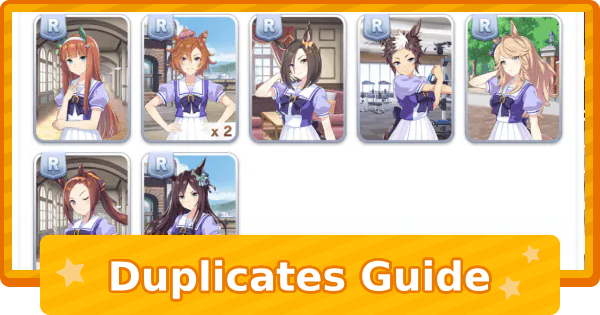 Duplicate Characters |
 Wit Stat |  Umamusume List by Year |
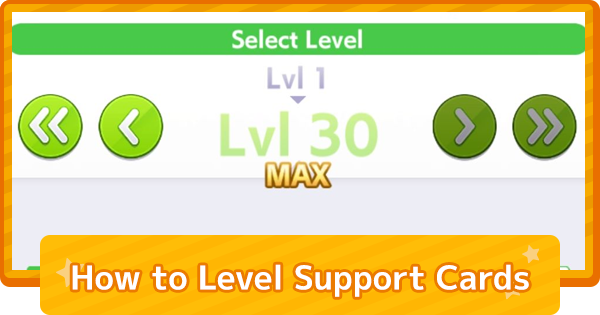 Level Up Support Cards |  How to Build a Support Deck |
 Reroll Guide |  |
 Legacy Affinity List |  |



